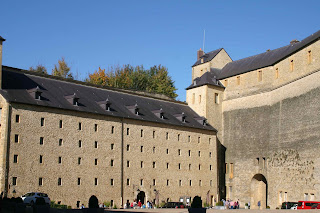We are now in the season of Lent, the 40 days leading up to Easter. Forty days is always a significant period in the Bible; Noah after all had to build an ark because it would rain for 40 days and 40 nights. These 40 days were intended to be a time of fasting, contemplation, and forsaking pleasures. The idea of "mardi gras," "Fat Tuesday," a day to be hog-wild just before the beginning of Lent, is a more recent development.
In the Middle Ages, Lent was taken seriously. Knights were not supposed to fight. Married couples were not supposed to have sex. Everyone was supposed to give up luxuries like meat. Now I'm sure that fighting and sex and meat-eating still went on, but that was the ideal. Late winter/early spring is at any rate an excellent time to celebrate eating very simply, because the food stored away in the autumn would be mostly gone, and it would still be too early for new crops. There might at best still be a final ham left saved for a good dinner. Easter lamb dinners doubtless began because the lambing season is right around Easter.
Because one was not supposed to eat meat during Lent, one could instead substitute fish. Fish, because it came from cold-blooded creatures, was always considered inferior to meat from mammals according to medieval people. They would be stunned at the promotion of the delicacy of king crab legs as appropriate for Lent. For that matter, medieval people were supposed to give up meat for the whole 40 days, not just the Fridays when restaurants now advertise their gourmet Lenten fish fries.
Lent finishes up with Holy Week, which commemorates events in Jesus's final week as a mortal, starting with Palm Sunday, when he was supposed to ride into Jerusalem on a donkey, greeted by people waving palm fronds. Thursday was the Last Supper, in which Jesus urged his followers to eat bread and wine in commemoration of him (the origins of Communion) and washed everyone's feet as a sign of humility.
Walking around the Middle East in sandals always got one's feet dirty, so washing one's feet or having it done was an important activity, just as getting a shoe shine once was in the US, before the wholesale switch to sneakers/athletic shoes or rough boots. Medieval monasteries replicated this foot washing, having poor people lined up and ready to have the monks minister to them.
Interestingly, the Last Supper looks a lot like a Passover meal, and Jesus had supposedly come to Jerusalem to be there for Passover, but Passover was celebrated on a Saturday, not a Thursday. One of the mysteries of trying to draw the historical tidbits out of gospels written a generation or two after the fact.
Friday of Holy Week of course was the day of the Crucifixion, a day of especial solemnity and personal deprivation, before the excitement and renewal of Easter itself on Sunday. Medieval people for the most part did not go to church very often, but if they ever went Easter was the day to do it, as it still is for many modern people. Indeed, the Lateran Council of 1215 ordained that all Christians should attend church on Easter. "He is risen" is an extremely powerful message and starts the real season of spring.
Note: medieval people did not have chocolate Easter eggs.
© C. Dale Brittain 2022
For more on medieval religion and holidays, see my new ebook, Positively Medieval: Life and Society in the Middle Ages.







